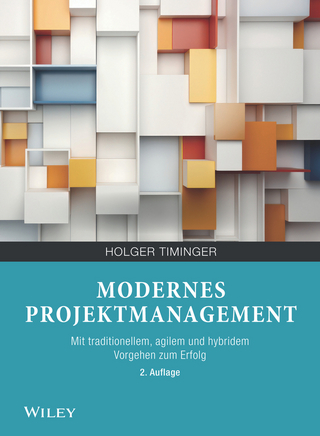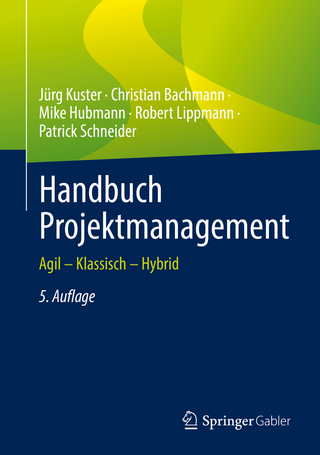
Code of Practice for Project Management
John Wiley & Sons (Verlag)
978-1-118-37808-3 (ISBN)
- Titel erscheint in neuer Auflage
- Artikel merken
- Offers a guide and reference to the principles and practice of project management in construction and development.
- Thoroughly updated and restructured to reflect the challenges that the industry faces today, this title continues to drive forward the practice of construction project management.
The first edition of the Code of Practice for Project Management for Construction and Development, published in 1992, was groundbreaking in many ways.
Now in its fifth edition, prepared by a multi-institute task force coordinated by the CIOB and including representatives from RICS, RIBA, ICE, APM and CIC, it continues to be the authoritative guide and reference to the principles and practice of project management in construction and development.
Good project management in construction relies on balancing the key constraints of time, quality and cost in the context of building functionality and the requirements for sustainability within the built environment. Thoroughly updated and restructured to reflect the challenges that the industry faces today, this edition continues to drive forward the practice of construction project management.
The principles of strategic planning, detailed programming and monitoring, resource allocation and effective risk management, widely used on projects of all sizes and complexity, are all fully covered. The integration of Building Information Modelling at each stage of the project life is a feature of this edition.
In addition, the impact of trends and developments such as the internationalisation of construction projects and the drive for sustainability are discussed in context. The Code of Practice will be of particular value to clients, project management professionals and students of construction, as well as to the wider construction and development industries. Much of the information will also be relevant to project management professionals operating in other commercial spheres.
The Chartered Institute of Building is at the heart of a management career in construction. It is the world's largest and most influential professional body for construction management and leadership, with a Royal Charter to promote the science and practice of building and construction for the benefit of society. With over 48,000 members worldwide, the CIOB is the international voice of the building professional.
Foreword xi
Acknowledgements xiii
Working group for the revision of the Code of Practice for Project Management - Fifth Edition xv
List of tables xvii
List of figures xix
List of diagrams - Briefing Notes xxi
Introduction 1
Project management 1
Definitions 1
Characteristics of construction projects 2
Characteristics of construction project management 3
Adding value 4
Scope of project management 4
Project lifecycle 4
1 Inception 11
Stage checklist 11
Stage process and outcomes 11
The client 12
Client obligations and responsibilities 12
Client project objectives 12
Client engagement: Internal team 12
Project manager 13
Project manager's objectives 13
Project manager's duties 14
Project manager's appointment 14
Project mandate 14
Environmental mandate 16
BIM mandate 17
BN 1.01 Leadership in project management 19
BN 1.02 Typical terms of engagement: Project manager 21
BN 1.03 Typical project mandate outline 26
BN 1.04 Project handbook 27
BN 1.05 Government Soft Landings 45
2 Feasibility 47
Stage checklist 47
Stage process and outcomes 47
Client's objectives 48
Outline project brief 48
Feasibility studies 48
Energy in a building environment 51
Lifecycle costing and sustainability 52
Sustainability in the built environment 52
Towards sustainable development 53
Responsible sustainable development 54
Achieving sustainable development 55
Site selection and acquisition 56
Project brief 58
Design brief 58
Funding and investment appraisal 60
Development planning and control 60
Stakeholder identification 61
Business case 61
Approval to proceed 61
BIM brief 62
BN 2.01 Key sustainability issues 63
BN 2.02 Environmental sustainability assessment methods 67
BN 2.03 Guidance on environmental impact assessment 72
BN 2.04 Site investigation 79
BN 2.05 Business case development 82
3 chapter Strategy 85
Stage checklist 85
Stage process and outcomes 85
Client's objectives 86
Project governance 86
Strategy outline and development 89
Project organisation and control 90
Project team structure 91
Selecting the project team 91
Project management procedures and systems 92
Information and communication technology 92
Project planning 94
Cost planning and controls 94
Cost control 96
Design management process (managing the design delivery) 97
Risk identification and management 98
Environmental management and controls 98
Environmental statements 98
Contractor's environmental management systems 98
Stakeholder management 99
Quality management 99
Commissioning strategy 100
Selection and appointment of project team consultants 100
Collaborative arrangements 102
Framework arrangements 102
Private public partnership/private finance initiative (PPP/PFI) 102
Procurement strategy 103
Traditional 103
Design and build 104
Management contracting 104
Construction management 104
Hybrid procurement approaches 104
Innovative form of procurement 105
Characteristics of procurement options 106
Procuring the supply chain 106
Responsible sourcing 106
Tender procedure 106
Procurement under EU directives 108
e-Procurement 108
Employer's requirement document 108
Facility management strategy/considerations 109
Project execution plan 109
Checklist for the PEP 110
Essential contents 110
Approval to PEP 111
BIM strategy 111
BN 3.01 Health and safety in construction including CDM guidance 113
BN 3.02 Guidance on value management 121
BN 3.03 Project risk assessment 124
BN 3.04 Information and communication technology 131
BN 3.05 Building information modelling 144
BN 3.06 Project planning 153
BN 3.07 Characteristics of different procurement options 154
BN 3.08 Framework agreements 158
BN 3.09 Procedure for the selection and appointment of consultants 160
BN 3.10 Selection and appointment of contractors 163
BN 3.11 Guidance on EU procurement rules 177
BN 3.12 Project governance 180
BN 3.13 Change management 184
BN 3.14 Strategic collaborative working 187
BN 3.15 PPP/PFI arrangements 193
BN 3.16 Guidance on e-procurement 209
BN 3.17 Design management process 213
4 chapter Pre-construction 217
Stage checklist 217
Stage process and outcomes 217
Design process 218
Managing the design delivery 218
Project coordination and progress meetings 219
Design team meetings 219
Managing design team activities 219
Statutory consents 221
Planning approval 221
Planning consultants 221
Legislation 222
Timing 222
Negotiations 222
Presentations 222
Refusal 222
Appeal 222
Enforcement powers 222
Other statutory consents 223
Building Regulations 223
Disability Discrimination Act (DDA) 224
Impact of utilities on project planning/scheduling 224
Technical design and production information 224
Value management 226
Contract award 226
Pre-start meeting 226
Agenda items at pre-start meeting 227
Introduction 227
Contract 227
Contractors' matters 227
Resident engineer/clerk of works' matters 228
Consultants' matters 228
Quantity surveyor's matters 228
Communications and procedures 229
Meetings 229
Contractual arrangements 229
Establish site 231
Control and monitoring systems 232
Contractor's working schedule 233
Value engineering (related to construction methods) 233
Management of the supply chain 234
Risk management 235
Payments 235
Benchmarking 236
Change and variation control 236
Dispute resolution 238
BIM strategy 239
BN 4.01 Regular report to client 241
BN 4.02 Dispute resolution methods 243
BN 4.03 Implications of Housing Grants, Construction and Regeneration Act 1996, Amended 2011 247
BN 4.04 Typical meetings and their objectives 248
5 chapter Construction 251
Stage checklist 251
Stage process and outcomes 251
Project team duties and responsibilities 252
Client 252
Project manager 252
Design team 253
Quantity surveyor 253
Contractor 253
Construction manager 254
Management contractor 254
Subcontractors and suppliers 254
Other parties 255
Performance monitoring 255
Health, safety and welfare systems 256
Environmental statements 256
Contractor's environmental management systems 257
Compliance with site waste management plan regulations 2008 257
Monitoring of the works 258
Reporting 258
Public liaison and profile 259
Quality management systems 259
Commissioning and production of operation and maintenance manuals 259
Commissioning 259
Operation and maintenance manuals 260
BIM strategy 260
BN 5.01 Performance management plan 261
6 chapter Testing and commissioning 263
Stage checklist 263
Stage processes and outcomes 263
Project manager's duties and responsibilities 264
Commissioning generally 264
Procurement of commissioning services 264
Smaller projects 264
Larger projects 265
Role of the commissioning contractor 265
The testing and commissioning process and its programming 266
Differences between testing and commissioning 267
Testing 267
Commissioning 268
Performance testing 268
Main tasks to be undertaken 268
Pre-construction 268
Construction and post-construction 270
Seasonal commissioning 270
Commissioning documentation 273
O&M manual (building owner's manual) 273
As-built documentation 274
Health and safety file 274
Occupier's handbook 275
BIM strategy 275
BN 6.01 Contents of the health and safety file 277
BN 6.02 Contents of building owner's manual 280
BN 6.03 Contents of occupier's handbook 283
7 chapter Completion, handover and operation 285
Stage checklist 285
Stage process and outcomes 285
Planning and scheduling handover 286
Procedures 286
Client commissioning and occupation 287
Operational commissioning 288
Main tasks 288
Client occupation 290
Structure for implementation 291
Scope and objectives 291
Methodology 291
Organisation and control 291
Soft landings 296
BIM strategy 296
BN 7.01 Client commissioning checklist 297
BN 7.02 Introduction to facilities management 299
BN 7.03 Engineering services commissioning checklist 300
BN 7.04 Engineering services commissioning documents 302
BN 7.05 Handover checklists 303
BN 7.06 Practical completion checklist 306
8 chapter Post-completion review and in use 307
Stage checklist 307
Stage process and outcomes 307
Post-occupancy evaluation 308
Project audit 308
Cost and time study 309
Human resources aspects 309
Performance study 309
Project feedback 310
Close-out report 310
Benefits realisation 311
Occupation/in-use strategy 311
Client's BIM strategy 311
BN 8.01 Post-occupancy evaluation process chart 313
Glossary 315
Bibliography 319
Past working groups of Code of Practice for Project Management 325
Index 329
| Reihe/Serie | Wiley Desktop Editions |
|---|---|
| Verlagsort | New York |
| Sprache | englisch |
| Maße | 210 x 297 mm |
| Gewicht | 1050 g |
| Einbandart | Paperback |
| Themenwelt | Technik ► Bauwesen |
| Wirtschaft ► Betriebswirtschaft / Management ► Projektmanagement | |
| Schlagworte | Bauingenieurwesen • Projektmanagement, |
| ISBN-10 | 1-118-37808-3 / 1118378083 |
| ISBN-13 | 978-1-118-37808-3 / 9781118378083 |
| Zustand | Neuware |
| Informationen gemäß Produktsicherheitsverordnung (GPSR) | |
| Haben Sie eine Frage zum Produkt? |
aus dem Bereich



